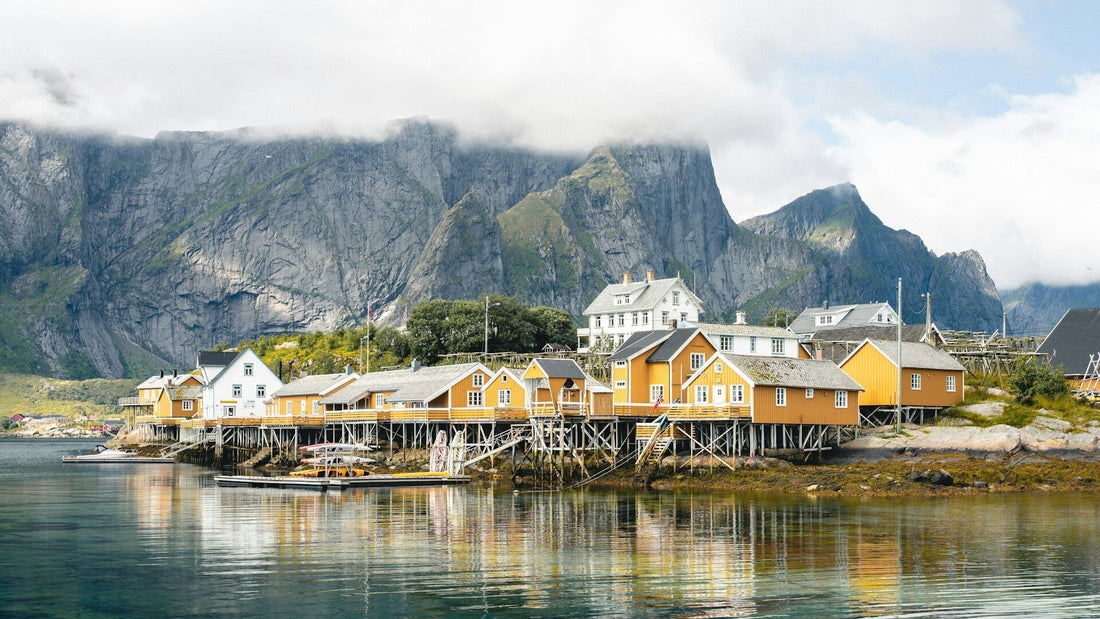Hej everyone,
Norwegian ceramics is a true gem of Scandinavian design. While brands like Figgjo and Porsgrund are internationally renowned, there is one manufacturer that has long been overshadowed: Arnold Wiigs Fabrikker.
From the 1940s to the 1960s, Arnold Wiigs Fabrikker produced exceptional ceramic pieces that combined Scandinavian minimalism with playful patterns and craftsmanship. Today, collectors and design enthusiasts are rediscovering the works of this Norwegian brand.
What makes the ceramics from Arnold Wiig's Fabrikker so special? Which designs are in demand today? And why is it worth taking a closer look at this almost forgotten factory?
Join us as we delve into the history of Arnold Wiig's Fabrikker – a brand that deserves to be brought back into the spotlight.
The story of Arnold Wiig's Fabrikker
The history of Arnold Wiigs Fabrikker (AWF) begins in the early 20th century. The factory was founded in Halden, Norway, and initially specialized in household ceramics.
But it wasn't until after World War II that AWF began to establish itself as an independent design brand. In the 1950s and 60s, when Scandinavian Mid-Century Modern style conquered the world, Arnold Wiigs Fabrikker created some of Norway's most iconic ceramic designs.
What made Arnold Wiig's Fabrikker so special?
☑ Scandinavian design with a Norwegian twist – clear lines, subtle colors, but often with playful patterns.
☑ High-quality craftsmanship – Each piece is carefully crafted, often hand-painted.
☑ Innovative production techniques – combination of traditional ceramic production and industrial efficiency.
☑ Influential designers – AWF collaborated with talented artists who shaped the style of the time.
The design of Arnold Wiig's Fabrikker: Mid-Century meets Folk Art
AWF's designs combine the minimalist charm of Mid-Century Modern style with strong roots in Norwegian folk art.
Typical features of AWF ceramics
🎨 Floral patterns – Many pieces feature hand-painted floral motifs in soft colors.
🔹 Geometric shapes – Clear, modern lines paired with traditional craftsmanship.
🌿 Natural color palette – earth tones, soft blues, deep greens – inspired by the Scandinavian landscape.
🏡 Functionality meets aesthetics – AWF not only produced art objects, but also tableware suitable for everyday use.
Iconic collections & designs
Arnold Wiig's Fabrikker production encompassed a wide variety of series—from simple tableware to elaborate decorative objects. Here are some of the most famous pieces:
1. The Blomster series (1950s)
This series was characterized by soft, hand-painted floral motifs. Plates and bowls with floral decorations in shades of blue and green were particularly popular.
2. The Geometrisk series (1960s)
The influence of Mid-Century Modern design is particularly evident here: clear lines, abstract patterns and a reduced color palette made this series particularly contemporary.
3. Hand-painted vases & bowls
AWF was known for its beautifully designed vases with unique color gradients and intricate glazes. Collectors, in particular, are now seeking out these special pieces.
4. Custom-made products for hotels & restaurants
Arnold Wiig's Fabrikker not only produced for the mass market, but also created bespoke collections for Scandinavian hotels. These pieces are particularly rare today.
Why is Arnold Wiig's Fabrikker making a comeback?
In recent years, interest in Mid-Century Modern ceramics has increased significantly – especially in Scandinavian brands that are less well-known but all the more fascinating.
3 reasons for the new popularity of AWF ceramics
- Sustainability & vintage trend – More and more people are looking for sustainable decoration and furniture with history.
- Collector value increases – Since many AWF pieces were only produced in limited quantities, they are now sought-after collector items.
- Unique design – The combination of mid-century aesthetics and craftsmanship makes AWF ceramics timelessly beautiful.
Collecting AWF ceramics: What should you pay attention to?
If you want to buy vintage ceramics from Arnold Wiigs Fabrikker, you should consider the following:
✔ Check condition – hairline cracks and chips can reduce value.
✔ Pay attention to the signature – Original AWF pieces often have a company stamp.
✔ Use online shops & flea markets – Many AWF pieces appear at collectors’ fairs and vintage shops.
How do you integrate AWF ceramics into your home?
AWF ceramics fit perfectly into modern and Scandinavian-inspired interiors.
🛋 Mix & Match : Combine AWF ceramics with other mid-century pieces for a stylish retro look.
🌿 Statement pieces : An AWF vase on a minimalist wooden shelf draws everyone's attention.
🍽 Use vintage tableware : Why not bring a touch of nostalgia into the kitchen with AWF plates?
Conclusion: Arnold Wiig’s Fabrikker deserves more attention!
For a long time, Arnold Wiig's Fabrikker was overlooked – but now this manufactory is experiencing a well-deserved renaissance.
The combination of high-quality craftsmanship, unique designs and Scandinavian aesthetics makes AWF ceramics a true treasure hunt for collectors and design lovers.
Whether you are looking for an original vintage piece or simply want to enjoy the beauty of Norwegian ceramics, Arnold Wiigs Fabrikker offers a fascinating world to discover.
Have you ever found a piece from AWF? Share your experience with us in the comments!



